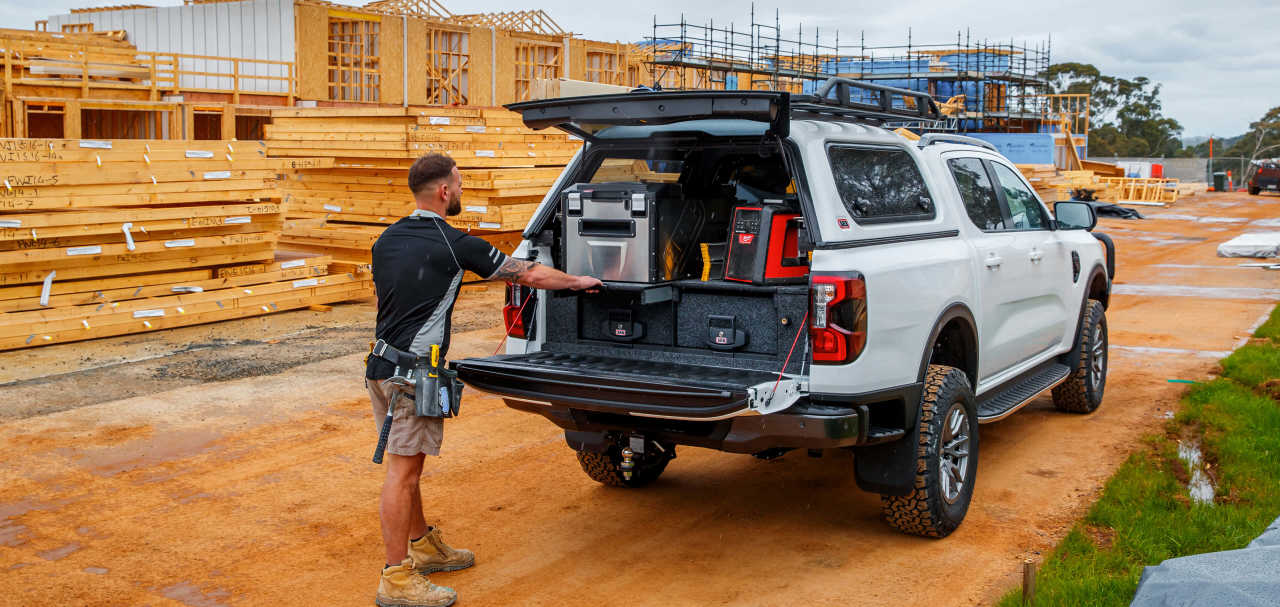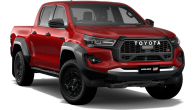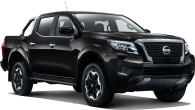It wasn’t so long ago that Chinese utes were largely ignored by Aussie buyers, as their design and engineering were clearly inferior to long-established market leaders.
However, Chinese automakers like BYD and GWM have proved to be fast learners judging by recent arrivals equipped with advanced hybrid drivetrains, excellent ride and handling, solid build quality, generous standard equipment and long warranties. And all at prices that offer tantalising value for money.
Proof of their increased buyer appeal can be seen in the latest VFacts industry sales figures for 2025 which show BYD’s Shark 6 PHEV, which went on sale in January, commands almost 10 per cent of Australia’s 4x4 ute segment. It’s topped only by the venerable Toyota HiLux and category-leading Ford Ranger.
Whether these numbers are sustainable after the usual early adopter rush remains to be seen, but there can be no denying this disrupter with its innovative plug-in hybrid drivetrain has hit the local 4x4 ute segment like a tradie’s hammer. We recently spent a week in one, to see how it performs from a tradie’s perspective.
BYD Shark 6 2025: Dual Motor Premium
| Engine Type | Turbo 4, 1.5L |
|---|---|
| Fuel Type | Premium Unleaded/Electric |
| Fuel Efficiency | 7.9L/100km (combined) |
| Seating | 5 |
| Price From | $57,900 |
Does it represent good value for the price? What features does it come with? 9/10?
9 / 10
The BYD Shark 6 is available in one model specification which combines two electric motors with an internal combustion engine, single-speed transmission and plug-in rechargeable battery for a list price of $57,900.
Our test vehicle is finished in 'Great White' (yeah, we get it) and comes with a standard equipment list as long as an extension ladder. There’s 18-inch alloys with 265/65 R18 tyres and a full-size steel spare, roof rails, side-steps, heated door mirrors, rear privacy glass, 360-degree camera view, front and rear parking sensors, LED lighting, fog lights and (useful for tradies) three 230V V2L (Vehicle to Load) three-pin outlets in the tub to power everything from tools to camping accessories.

Step aboard using the keyless entry/start and you’ll find synthetic leather-appointed seats with the front buckets offering heating/cooling and multiple power adjustment.
The driver also gets a genuine leather-wrapped steering wheel with multiple remote functions plus a 10.25-inch LCD instrument display and head-up display.

There’s also dual-zone climate control, wireless phone-charging, USB-A/USB-C ports and 12V/230V V2L power outlets plus premium 12-speaker sound for a multimedia system offering voice assistance, digital radio and wired or wireless connectivity for Apple CarPlay/Android Auto devices.
Media and many other vehicle functions are controlled by a large 15.6-inch touchscreen on the dash, which can power-rotate between landscape and portrait positions according to personal preference.
Is there anything interesting about its design? 8/10?
8 / 10
Our test vehicle rides on a 3260mm wheelbase and is 5457mm long, 1971mm wide and 1925mm high, so it’s in the same ballpark as a Ford Ranger 4x4 dual cab ute.
The Shark 6 features traditional body-on-frame truck chassis design, double-wishbone coil-spring front and rear suspension, rack-and-pinion steering and four-wheel disc brakes.
It also has a compact 11.0-metre turning circle and its off-road credentials include 230mm of unladen ground clearance, 700mm wading depth and 31 degrees approach/17 degrees ramp-over/19.3 degrees departure angles. A large metal bash-plate protects the underside.
Looks are subjective of course and even though there’s too much external black plastic for our liking, we reckon it still passes the pub test on styling with its chunky and purposeful appearance.
The bold grille and headlight design appears to draw inspiration from full-size US pick-ups, but with a ‘technical’ look consistent with its high-tech powertrain.
The predominantly grey interior has a high-quality finish and looks good. It also appears to draw inspiration from rivals, in this case the Ranger Raptor with its contrasting bright red air-vent/cupholder surrounds and exposed stitching along numerous seams.
How practical is its space and tech inside? 8/10?
8 / 10
With its hefty 2710kg kerb weight and 3500kg GVM, the Shark 6 has a 790kg payload rating which is less than some turbo-diesel rivals.
It’s also rated to tow up to 2500kg of braked trailer which is 1000kg less than the category benchmark. And BYD does not publish a GCM (Gross Combination Mass) rating, so we don’t know how much weight the Shark 6 can legally carry and tow at the same time.
The load tub is almost square with its 1520mm length and 1500mm width. And with 1224mm between the rear-wheel housings, it can carry either Aussie or Euro pallets. Its 517mm depth results in 1.2 cubic metres of total load volume.

There are six load-anchorage points but those located in the sidewalls at the front and centre of the tub are too high for securing low-profile loads. Anchorage points located near floor-level are preferable, as they can secure loads of all heights.
The tub’s internal surfaces are protected by a spray-in liner and there’s bright internal lighting and a hydraulic strut to ease tailgate operation.
Seating for the driver and front passenger is spacious and comfortable. The rear bench seat shares similar qualities, given I’m 186cm tall and when seated behind the driver’s seat in my position I still have ample kneeroom.

Rear seat passengers also enjoy sufficient headroom, even for tall people seated in the least popular central position who also have a nice flat floor given the absence of a transmission tunnel. However, shoulder room for adults sitting three-abreast is tight and best limited to short drives.
Cabin storage for front seat occupants includes a large-bottle holder and bin in each front door, overhead glasses holder plus a dash storage shelf and glove box on the passenger side.
The centre console has two small-bottle/cupholders in the centre and a lidded box at the back.
Rear passengers also get a large-bottle holder and bin in each door, plus pockets on the rear of both front seat backrests and a fold-down centre armrest with two small-bottle/cup-holders.
The bench seat’s base cushion can be raised and stored vertically if more internal luggage space is required, but there’s no under-floor storage.
What are the key stats for its engine and transmission? 8/10?
8 / 10
The Shark 6’s hybrid drivetrain with permanent all-wheel drive includes two electric motors, with the front motor producing up to 170kW/310Nm driving the front wheels. The rear motor produces up to 150kW/340Nm and drives the rears.
These motors are teamed with a 1.5-litre turbocharged four-cylinder petrol engine producing up to 135kW/260Nm, which serves dual roles as a generator to maintain charge in the 29.58kWh lithium-ion battery (in addition to regenerative braking) and to assist with driving the front wheels as required. It can also perform both roles simultaneously.

The combined output of electric motors/petrol engine is up to 321kW and 650Nm. There are also three selectable drive modes comprising Eco, Normal and Sport, plus different terrain settings to optimise performance in Mud/Sand/Snow/Mountain.
The plug-in battery can be charged using either the AC (7.0kW) or DC (55kW) ports. Cables for both were supplied with our test vehicle and stored in a carry bag behind the rear seat.
What is its fuel consumption? What is its driving range? 9/10?
9 / 10
BYD claims combined average fuel consumption for the petrol engine as low as 2.0L/100km with 25-100 per cent SoC (State of Charge) which spikes to 7.9L/100km when SoC drops below 25 per cent (see Driving).
BYD also claims an NEDC battery-only driving range of up to 100km (with 25-100 per cent SoC) and up to 800km when combined with the petrol engine in hybrid mode.
We covered 522km during our test which was a mix of city, suburban and regional roads plus some highway driving, of which about one fifth of that distance was hauling a near-maximum payload.
At the completion of our test, the Shark 6’s onboard computer claimed average petrol consumption of 6.6L/100km with 204km of range remaining, which suggests a real-world driving range of at least 700km is credible from its 60-litre petrol tank.
What’s it like to drive? 8/10?
8 / 10
The seating is comfortable and supportive and the driving experience is enhanced by the head up display, large left footrest and thick-rimmed leather wheel.
It’s quiet to drive and the ride quality is outstanding, with refined and disciplined suspension tuning combined with responsive steering and braking. It all adds up to handling agility on winding mountain roads that belies the fact it’s a high-riding 2.7-tonne ute.
Rapid acceleration from standing starts (BYD claims 0-100km/h in just 5.7sec) is also effective in masking its bulk, as instant torque from the dual electric motors gets it rushing towards triple-digit speeds with unrelenting ease, regardless of gradient.

We did most of our test in the ‘Normal’ (default) drive mode, as it provides a happy medium between the heightened response of ‘Sport’ and the slightly subdued ‘Eco’ modes.
To test its GVM rating, we loaded 650kg into the load tub which with driver equalled a 750kg payload that was only about 40kg less than its legal limit. The independent rear suspension compressed about 60mm, but there was no bottoming-out detected as it competently hauled this load on our test route.
Although the ‘Energy Manager’ on the touchscreen allows drivers to pre-set a minimum SoC between 25-70 per cent, we didn’t enter any setting as we wanted to see how the hybrid system performed without these inputs.

Fact is, it did not allow the SoC to drop below 20 per cent, even during highway driving when there was minimal charging assistance available from regenerative braking.
As displayed live on the energy manager, the petrol engine maintained the battery charge needed to feed the electric motors while also providing intermittent drive to the front wheels as required.
At times the little 1.5-litre turbo engine sounded like it was working very hard doing this, but it did prove effective in performing these dual roles.

The hybrid system also produces minimal engine-braking (even with maximum regenerative braking) which is an important consideration if you regularly carry and/or tow heavy loads, particularly in hilly terrain.
With a traditional turbo-diesel and multi-speed transmission, a low gear can be manually selected to allow the engine on overrun to assist the brakes in restraining loads on steep descents. However, with its single-speed transmission and small petrol engine, the Shark 6 must rely on brakes alone.
Warranty & Safety Rating
What safety equipment is fitted? What safety rating? 9/10?
9 / 10
The Shark 6 was awarded a maximum five-star ANCAP rating in 2025. It has multiple airbags including front and rear side-curtains, AEB including cyclist and pedestrian detection, lane-keeping, adaptive cruise control, front and rear parking sensors, rear cross-traffic alert, blind-spot monitoring, a 360-degree camera view and lots more. The rear seat has top-tether and ISOFIX child-seat anchorages for the two outer positions.
What warranty is offered? What are its service intervals? What are its running costs? 8/10?
8 / 10
The Shark 6 is covered by BYD's six-year/150,000km warranty and an eight-year/160,000km battery warranty.
Scheduled servicing is every 12 months/20,000km whichever occurs first. Capped-pricing for the first six scheduled services totals $2945 or an average of $490 per year.
Verdict
The Shark 6 breaks new ground with its PHEV technology and impresses with not only its whisper-quiet and rapid acceleration but also engaging chassis dynamics, build quality, fuel economy and generous standard equipment for a compelling price. However, its modest payload and tow ratings may be deal-breakers for some tradies and recreational buyers with bigger loads to haul.
Pricing Guides

Range and Specs
| Vehicle | Specs | Price* |
|---|---|---|
| Dual Motor Premium | 1.5L, Premium Unleaded/Electric, SPEED CONTINUOUS VARIABLE | $57,900 |


.jpg)










.jpg)








.jpg)

.jpg)
.jpg)

.jpg)
.jpg)